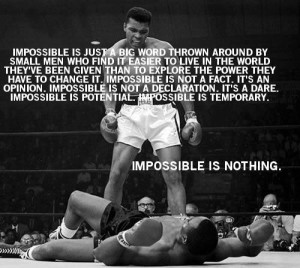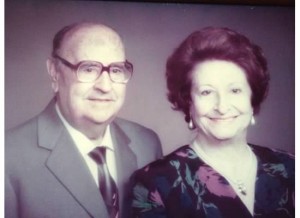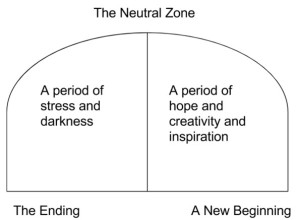Recently, I read the book “The Fight” by Norman Mailer that chronicles the 1974 heavyweight boxing match known as the “Rumble in the Jungle”. Set in Kinshasa, Zaire in Africa, this fight saw the imposing brute champion George Foreman challenged by the aging former champ Muhammad Ali. Against seemingly insurmountable odds, Ali beats Foreman to regain the title by summoning physical, mental, and spiritual forces.
The book is a compelling read, even for those with no interest in boxing. Ultimately, it is not the story of a sports event. It is the story of a person writing his own history moment by moment, forging his own destiny in defiance of both the gods and all common sense. It is Muhammad Ali’s blueprint for how to do the impossible.
Today we think of George Foreman as a benevolent, pudgy grandpa selling grills on TV. And we think of Ali as the greatest fighter of all time. But in 1974, both of those characterizations were decades away.
In 1974 at the height of his career, Foreman’s ferocity and sheer physical power were staggering. He brutally dispatched legends of that era like Ken Norton and Joe Frazier as if they were amateurs. By contrast, at the age of 32, Ali seemed to be past his prime and fading fast. In his preceding fights, Ali struggled to barely win against boxers who Foreman had previously obliterated. Some in the boxing world legitimately feared Ali might be killed in the ring during this fight.
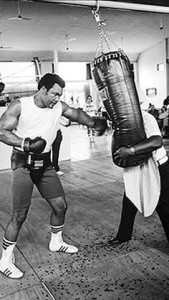
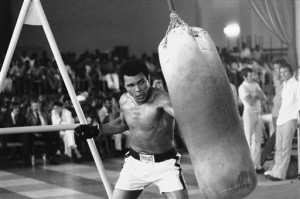
But Ali had other plans. He was both a brilliant tactician and an unearthly visionary. In my reading of Mailer’s book I see four essential qualities that Ali brings to bear in his path to an impossible victory, qualities we all can emulate:
Audacity
At the very start of the fight, Ali does something radical: the first punch he throws is a right hand lead. For a boxer whose main strength is speed, this is an unusually aggressive tactic. The right hand lead is a power punch, usually deployed in the later rounds when an opponent is already worn out. It was widely expected that Ali would play to his strength by peppering Foreman with many quick jabs through the early rounds of the fight. Any power punches thrown by Ali would come much later. That had been his pattern for many years.
So to throw a right hand lead at the start of Round One is outrageous. Ali knows he will not knock out Foreman with this punch, or even really hurt him. And he leaves himself vulnerable to a deadly Foreman counterpunch. In this case, the right hand lead from Ali is a message, a declaration of disrespect, an insult. Foreman was duly insulted. This provocation was the last thing he expected. Enraged, Foreman was thrown off his game plan from the first moment of the fight. Mentally, he would never recover. Such bold, unconventional thinking gave Ali the immediate advantage.
Intelligence
The right hand lead was just the beginning of Ali’s psychological dominance of Foreman. Once provoked, Ali knew that Foreman would come after him with a furious vengeance. So he set the most famous trap in the history of sports: the Rope-a-Dope. In this tactic, Ali leaned back against the ropes, covered up and just let Foreman punch away at him. Occasionally he would clutch Foreman around the neck and whisper taunts “Is that all you got George? They told me you hit hard George, so hit me”.
Ali set the trap and George could not resist waltzing right in. Foreman was an aggressive, unrelenting fighter. Knowing he could not overpower him, Ali lured Foreman into punching himself into exhaustion. His guile in devising the Rope-a-Dope and executing it to perfection was nothing short of genius. Ali shows us intelligence can turn your own weaknesses into strengths and turn your opponent’s strengths into weaknesses.
Endurance and Evasion
The Rope-a-Dope was a brilliant plan but Ali knew it was no free ride. Some of Foreman’s punches would get through his defenses. Foreman possessed one-punch knockout ability. To this day he is considered one of the hardest punchers in boxing history. Months before the fight, Ali knew he would have to manage Foreman’s lethal onslaught.
Though he possessed a tough chin (he could take a direct punch), Ali had to block and absorb Foreman’s attack to succeed. Throughout the fight, his hands, arms, and elbows shifted with lightning reflexes as wave after wave of Foreman punches rolled in. Here the Rope-a-Dope stance proved a key asset. The ropes to his back acted as a shock absorber for Ali diminishing the impact of each punch that Foreman landed. If you watch the fight online you can see Foreman landing what looks like big punches, all with little or no effect on Ali.
In addition, Ali practiced a technique for evading punches while training for the fight. With superhuman dexterity, he could turn away from the full force of a punch in a nanosecond. His opponent’s glove would pass within millimeters or gently graze his skin. After the fight, he famously said “I have a radar built inside me; I know how to judge punches.”
In life we all take our share of metaphoric blows. Ali’s game plan was a simple one, and serves as an example we all can follow: evade what you can, endure what you must, find a shock absorber to lean back on.
Belief
Ali was known as a braggart who did not lack in self-confidence. But his bravado was mostly an act, a part he played to promote fights, sell tickets. The run up to Rumble in the Jungle changed him. Due to a medical issue with Foreman, the original fight date was postponed for four months. Ali stayed in Zaire training the whole time, six months in total. In that time he developed a deep connection with his African roots and the African people. Ali came to see the fight as a spiritual quest. In his mind and soul, there was no difference between the physical struggle and the metaphoric one.

In the days before all those Rocky movies, no one thought of boxing as a metaphor for life’s struggles. Boxers fought for money or glory or because they sought an outlet for their violent nature. Muhammad Ali was the first boxer to truly believe his work had a higher purpose. In this fight above all, he embodied this belief in its purest form. He stood alone in the ring as a single man, but believed he was a conquering hero fighting a monster for the salvation of millions.
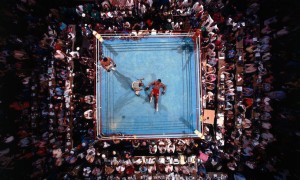
Muhammad Ali knocked out George Foreman in the 8th round of the Rumble in the Jungle. But he was no longer content to be World Heavyweight Champion. He wanted it all, he wanted to be the Champion of the World. If you listen carefully at the end of the video of the fight, the announcer literally says: “the great man has done it…the thing they said is impossible he’s done”. Ali did the impossible not for money or glory. He did the impossible to show the world that anyone can.
